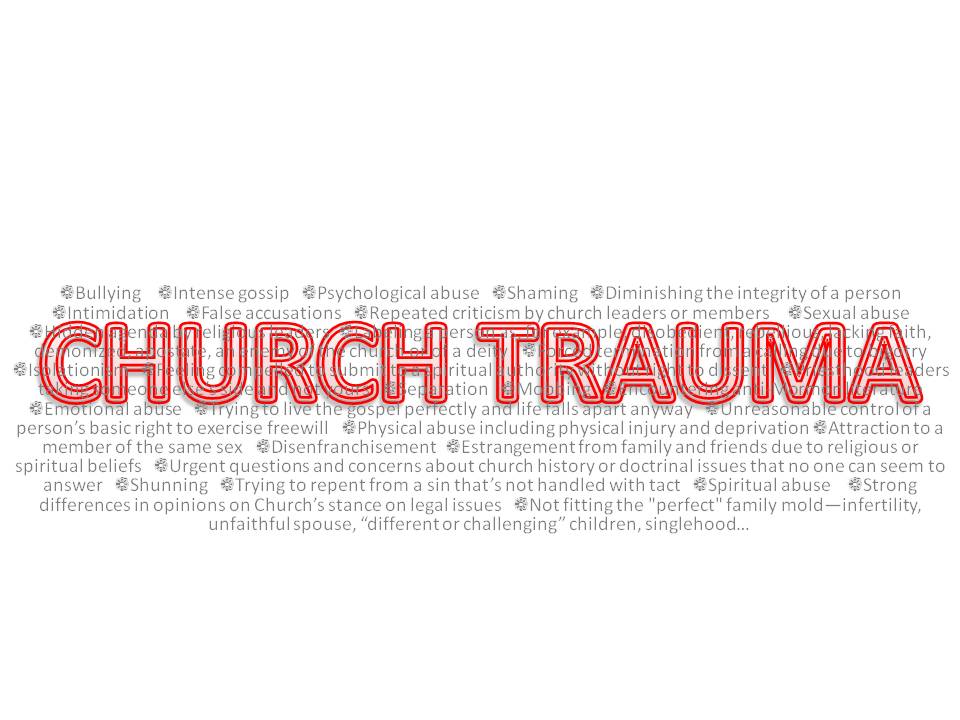
What Are The Roots Of Mormon Trauma?
SHHHHH! I want to share a secret with you. I already wrote this article. I’ve been writing this article on Mormon Trauma for a few weeks now actually. And I have struggled with it. Originally, I wrote this article with the intention that I did not want to alienate anyone because church trauma within the LDS faith is not widely known. I did not want to be deemed an anti-Mormon or apostate because of what I wrote. I did not want to be called a sensationalist. I didn’t want to hear that I was too angry or hateful. I wanted to avoid being told I was over-reacting or being too sensitive.
So, I sugarcoated the issues and I glazed over the problems. I cautiously chose words that weren’t inflammatory and softened the points of controversy. I tiptoed between the lines and I treaded lightly in my conclusions. The end result was a lackluster article that was not reflective of what is really happening in our midst. I couldn’t bear to put my name on an article that sold out the issues to make them palatable for the public. I re-wrote the article, this time with language that was honest, examples that were real, and conclusions that are astounding. The whole experience left me more resolute to dig deep and uncover the roots of church trauma with the Mormon faith.
We cannot sugarcoat the issues. These issues are causing pain. They are causing trauma. They are causing mental illness. They are even causing people to take their own life.
Before you think I am being sensational, please read the personal stories on Protect LDS Children.
Before you think I am angry or hateful, please speak to one parent of a child who took their own life because of shame, bullying, or lack of acceptance within the church.
Before you think I am over-reacting, please read about Church Trauma and Religious Trauma.
Before you think I am too sensitive, please become informed about spiritual abuse on Time For Cambio and Unrighteous Dominion
Is there an easy way to talk about these things?
No. Not when so much hurt, pain, and trauma has been caused. It is heart-aching and heart-breaking. But, it is necessary and needed. Now, for my revised article:
I’ll back up a bit and introduce myself. I’m Lesley and I am honored to be a part of the MTM team to address the issue of Church Trauma within our community of Mormonism. This is a worthy cause that I believe in.
Danna Hartline has previously covered the effects of church trauma. They are numerous and can be devastating. These effects include things like fear, confusion, cognitive dissonance, church exodus, abuser loyalty, dissociation, loss of identity, mental disorders, family dysfunction, shame and suicide.
The Church Trauma Tree is the work and creation of Danna Hartline. 
I’d like to touch on and explain the roots of these problems, which can cause the trauma in the first place. Because these involve beliefs, values, and doctrines that many of us have been raised with but may also hold difficulty for members, I’m giving a Trigger Warning for the remainder of this article. Truthfully, there are many root issues that can exist for church members, but some of the more common ones are:
- Organizational Behavior
- Patriarchal Structure
- Unrighteous Dominion
- Unsafe Policies
- Cultural Behaviors
- Church Doctrine
- Unsustainable History
- Discrimination
Organizational Behavior
We have an expectation that our church, as a community of faith that bears the name of Christ will act in ways that uphold these standards and expectations. We expect the organization to follow the example that we are taught within its wall each Sunday. Principles like accountability, responsibility, repentance, unconditional love, and humanistic-centered belonging are tenets of our beliefs. However, sometimes we see the church not follow these principles that we hold in our hearts as true and just, particularly when it comes to corporate and institutional dealings. More specifically, we see un-Christlike behavior by the institutional church regarding those who have been victimized or abused within the system. We have seen predators protected and abuser s enabled. It is painful and astounding to see doublespeak, hypocrisy, victim-blaming and even highly unethical activity from our church that claims to believe in the Savior’s example. A recent MormonLeaks document, shows the use of the bishops hotline (instituted by the LDS Church) to conceal and cover abuse, protect predators, and show no concern to victims of this type of monstrous behavior. Our church is behaving more like a corporation rather than a community of faith. This causes trauma to abuse survivors and dissonance for followers of Christ and his teachings.
Patriarchal Structure
Our church is built upon a hierarchal, patriarchal structure. More specifically, our system is a benevolent patriarchy, where women are “pedestalized” and decisions are made mostly by men for their best interest. Furthermore, a theological complementarian approach is adopted, which promotes definitive gender roles and traditional family structure. This means that men function as the leaders, but are assumed to do so humbly and sacrificially for the benefit of all. Despite the even the best of intentions, outcomes in these systems adversely effect those who are oppressed. Problems with patriarchy can run deep, for both women and men, as patriarchy is abusive. When women are not represented in leadership and decision-making, it can lead to blind spots in logic and thinking that are harmful and oppressive to women and many other groups of people. Things like rape culture, toxic masculinity, and power imbalances exist within patriarchal structures, even within the Mormon benevolent patriarchy. This are not things we want to pass to our children. Studies show that women who had female church leaders as a youth are more likely to experience higher self-esteem as adults (Religion News Service). We must do better.
Unrighteous Dominion
We have a special name for abuse of power and authority within our church that comes from our canonized scriptures. In Doctrine and Covenants Section 121:39 it states, “We have learned by sad experience that it is the nature and disposition of almost all men, as soon as they get a little authority, as they suppose, they will immediately begin to exercise unrighteous dominion.” Essentially unrighteous dominion is spiritual abuse. It can be extremely damaging and abusive when church leaders perpetrate this abuse upon members. It is used to silence, intimidate, coerce, and manipulate others and does not foster a safe leadership structure. Victims of domestic violence often experience spiritual abuse if they are involved in a religious system. While national statistics indicate that one in four females and one in seven males are victimized by a current or former intimate partner, spiritual abuse is a tactic overwhelmingly perpetrated by men against women (Joyful Heart Foundation). Personal accounts of unrighteous dominion are often devastating and debilitating. Experiencing this specific type of abuse can be extremely confusing and effect an individual’s ability to feel worthy of God’s love.
Unsafe Policies
Recently, Sam Young has lead the Protect LDS Children movement in order to raise awareness and call for safe and ethical policies involving children and bishops interviews within the church. Protect LDS Children is calling for “No one-on-one interviews, no sexually explicit questions. Ever.” Unsafe policies like interviewing children alone behind closed doors can enabled grooming practices. Asking them sexually explicit questions to assess for worthiness can lead to shame and guilt. These things can also lead to sexual abuse of children. This has no place in our community of faith. It must change to promote healthy boundaries and encourage positive self-identity for our children. The church also does not currently have a means for members to report abuse by a church leader. This is highly problematic and unethical. In addition, more recently, personal accounts of missionaries being sexually assaulted while serving and being mishandled have come to light. The issues of disconnect between formal policy and actual implementation of policy is undeniable and needs to change.
Cultural Behavior
We have all been in church meetings where something is said which is not doctrine, but it is touted as such. Does anyone speak up and correct this mistake? Many times, we experience groupthink situations within the church, which can cause us to doubt our own reality, stifle individual voice, and create unsafe circumstances that cause harm or discomfort. This contributes to gaslighting within our culture. The Latter-Day Saint community also operates within it’s own unique Identity Culture. Identity culture is created within Mormonism by the specific standards, values, and beliefs within the church. Because of this, we interact in a unique system that informs and influences our actions and reactions. When someone does not fit the mold, we may see mob mentality and herd mentality begin to form in order to preserve the status quo, maintain the existing culture and reinforce acceptable behavior of the group as a whole. We also see a hierarchy established within the culture itself, being informed by the identity culture established. Status symbols like temple recommends, temple marriage, missionary service, and even prestigious church callings signal a person’s “worthiness and righteousness” within our cultural constructs. Pride is attached to being called as Bishop or Relief Society President. There is an assumed trust and instant loyalty being given to those that have these credibility factors within the church. In addition, soft power is also attached to these status symbols, which means others experience oppression because of it. Obviously, this is highly problematic and causes an ” Us vs. Them” dichotomy that is enveloped within our culture.
Church Doctrine
Within the Mormon faith, there are foundational doctrines that are widely accepted even when they are problematic. The books Mormon Doctrine by Bruce R. McKonkie and The Miracle of Forgiveness by Spencer W. Kimball, contain several traumatic and shaming passages that hurt and confuse church members. Problematic doctrines of the church include polygamy, eternal gender roles, salvific nature of the traditional family, Priesthood authority, necessity of tithing, and older doctrines that were taught by church leaders like the Adam-God doctrine and blood atonement. There are also more conceptual aspects like prosperity gospel, the assessment of worthiness, the infallibility of leaders, the spirit of discernment, necessity of confession, and obedience as an absolute. As problematic as some church doctrine is, it is also very difficult to define, adding to the frustration of members should they seek answers for their questions. This causes confusion, dissonance and fog for members, which in many cases leads to trauma. It can spark a faith crisis because of the cognitive dissonance that is felt upon wrestling with these issues.
Unsustainable History
We have a rich and unique history being a Restorationist religion founded in America last than 200 years ago. Despite its relatively new roots, Mormonism carries with it difficult history, that may lack multi-perspective views, contain instances of repression and deception, an often does not align with the dominant narrative that is found and taught within the church. A few examples of this are:
- Joseph Smith’s translation vs. revelation issue regarding the Book of Mormon
- Joseph Smith using a seer stone in a hat, instead of translating from the Gold Plates directly
- Joseph Smith’s own practice of polygamy with young women without Emma first knowing or approving
- The practice of polygamy harming and hurting countless women and children
- The papyri which became the Book of Abraham found to be a funerary text in actuality
- Multiple accounts of the First Vision which are different in important key details
- Brigham Young’s problematic views regarding women and people of color
- Mountain Meadows Massacre found to be falsely portrayed by the church as to the murder of 120 people
Often we are seeing that historical events contain problematic narratives that put Mormons and the church overall in the best light rather than truthfully telling the facts. As we learn more in this information age, there are several historical accounts that are not sustainable as more evidence and information has come to light.
Discrimination
Marginalized groups do exist within the Mormon faith, most notably those who identity with the LGBTQ+ community, persons of color, and women and many others. Members feel cast off, discarded, and discounted because of their sexual orientation or gender identity. We have a lack of diversity among leadership, which contributes to insensitive and even harmful policies that affect these groups profoundly. Historically, the Priesthood Ban prevented the integration of black men from holding the priesthood until is was lifted in 1978. Too often, we see an absence of people of color being included in conversations of important issues. We may use/hear terms and cultural appropriations that are offensive to these groups and do not foster or promote inclusion or even respect. Women have also suffered from overt and covert sexism within the church. Recently, a policy, known as The Exclusion Policy, stating the children of parents living in a same-sex relationship cannot obtain a name and a blessing, be baptized and confirmed, or ordained without specifically disavowing same-sex marriage. This is unimaginably harmful and can damage a child’s relationship with their family. Furthermore, recent statistics show that suicide is the leading cause of death for Utah youths ages 10 to 17, and that the suicide rate in Utah for all ages is more than 60 percent above the national average (SL Tribune). When compounded with statistics that show that “LGB youth are almost five times as likely to have attempted suicide compared to heterosexual youth, 40% of transgender adults reported having made a suicide attempt with 92% of these individuals reported having attempted suicide before the age of 25,” (The Trevor Project) the conclusions are alarming.
How To Help The Trauma And Heal The Pain
All of these roots are messy and entangled within our belief system, which means it will be a tedious task to dig down deep to uncover these roots and see what they look like for each of us. This is a process that surely involves self-archaeology. We must have this foundational understanding of the roots of church trauma to grow in hope and healing.
5 Things We Can Do Right Now:
- We can advocate for safer policies and ethical organizational behavior.
- We can stop accepting, enabling, and condoning spiritual abuse and unrighteous dominion.
- We can lend support and love those who have experienced a faith transition because of problematic doctrine or history.
- We can validate those who have felt the painful devastation of abuse and discrimination.
- We can connect with those around us, thus creating a healthy and holistic community of caring.
This is my goal as a team member of Mormon Trauma Mama. Yes, these issues are difficult to talk about because they are painful. Yes, we will all have different root causes and experience different effects. Yes, no two paths are exactly alike. Despite the differences, we can build on the commonalities. We can offer support and hope to the community that we share as trauma survivors. This community is beautiful and true, because it is built on authenticity and common ground. Let’s live the acceptance, love and validation that many of us did not have.
Because Mormon trauma is real. And we are proof.




4 Comments
Lori
Thank you!!
Julia Carpenter-Morehead
Good job. I’m going through trauma from within our school district that where my rights as a woman and a mother were violated and led to the death of my daughter. I have said they are treating it like a cooperation not a school and have hurt so many people. When I heard you say the same thing there was such a resonance. You and Danna have helped put structure to institional abuse that I feel will be a template for other groups to form specific to their situation.
Also, I have been a Trauma Touch Therapist and body worker for 28 years and there are many introductory or basic techniques that can help integrate trauma as well as advanced processes as a person becomes more familiar with connecting to and transforming traumatic experiences that are anchored in the body.
Geri Harames
Julie, Thank you for sharing your comment, I am so sorry to hear about the death of your daughter. I hope this group is able to help you and others with more great articles and posts to come.
Jean Eisenhower
Just discovered your blog. Great video. I’m a former Mormon mind control subject. I’ll be reading and watching more. Thanks!